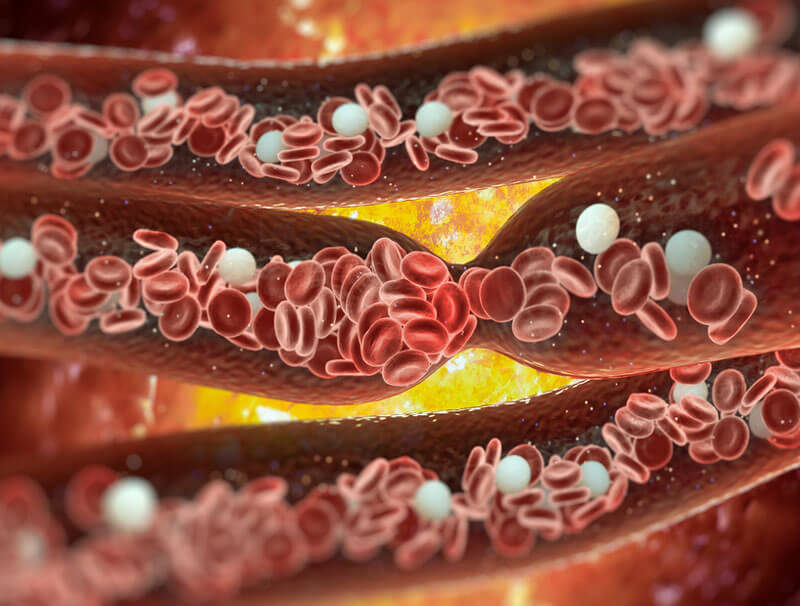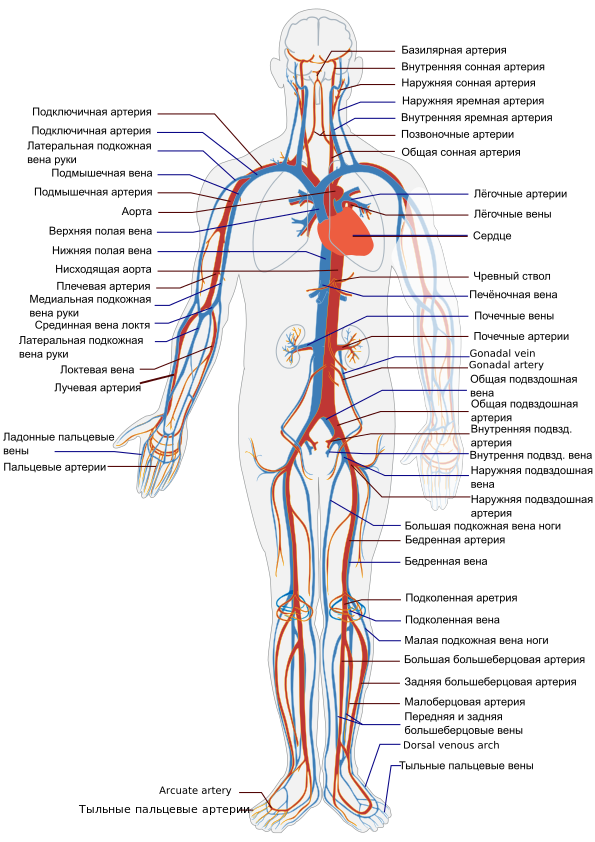How to improve the condition of blood vessels

Vessels are the transport system of our body. They deliver blood to the cells and tissues, saturated with oxygen, and remove from them metabolic products and toxins.
In addition, the blood flowing through the blood vessels, heats our body and maintains body temperature at a constant level.
The important role of blood vessels in life is conditioned by the fact that we need to take care of them throughout life.
Blood circulation, Cardiovascular system, Blood vessels
Circulation is the circulation of blood throughout the body. In primitive living organisms, for example, ringworms, the circulatory system is closed and is represented only by blood vessels, and the role of the pump (heart) is performed by specialized vessels that have the capacity for rhythmic contractions. The circulatory system is also found in arthropods, but it is not closed in a single contour. In primitive chordates, for example, lancelets, blood circulation is carried out along a closed contour, the heart is absent. Beginning with representatives of the fish class, the blood is set in motion by cardiac contractions and circulates through the vessels. Blood supplies the tissues of the body with oxygen, nutrients, hormones and delivers the metabolic products to the organs of their secretion. Enrichment of blood with oxygen occurs in the lungs, and saturation with nutrients - digestive organs. In the liver and kidneys there is a neutralization and withdrawal of metabolic products. Blood circulation is regulated by hormones and the autonomic nervous system. Distinguish small (through the lungs) and large (through the organs and tissues) circles of circulation.
The cardiovascular system is a system of organs that ensures the circulation of blood in the human body and animals. Through the circulation of blood, oxygen, as well as nutrients are delivered to the organs and tissues of the body, and carbon dioxide, other metabolic products and waste of life are removed. Circulation of blood in the cardiovascular system in vertebrate animals and humans is supplemented by lymphatic drainage from the organs and tissues of the body according to the system of blood vessels, nodes and ducts of the lymphatic system that flow into the venous system at the point of confluence of subclavian veins. The cardiovascular system includes the heart - an organ that causes the blood to move, pumping it into blood vessels - hollow tubes of various calibers, over which it circulates. All the functions of the circulatory system are strictly coordinated thanks to the neuro-reflex regulation, which allows maintaining homeostasis in conditions of constantly changing conditions of the external and internal environment.
Blood vessels - elastic tubular formations in the body of animals and humans, through which the force of the rhythmically contracting heart or pulsating vessel carries the movement of blood through the body: to organs and tissues along arteries, arterioles, arterial capillaries, and from them to the heart - through the venous capillaries, venules And veins.
What are the vessels in the body?
We will not go into the anatomical details, just outline the main features of each type of vessels. So, in the body there are:
- Arteries. These vessels have the largest cross-section and are considered to be main lines. Through them, blood enriched with oxygen, enters all cells. The walls of the arteries are elastic and elastic: it is necessary to ensure uninterrupted flow of blood. In these vessels, the blood flow velocity is maximum, so their walls are also very strong. The largest artery in the body is the aorta, it serves as a blood conductor to the upper and lower half of the trunk.
- The veins. These vessels provide an outflow of blood containing carbon dioxide and a variety of metabolic products. Thanks to them, cells are also released from toxins. The blood flow in the veins is much slower than in the arteries. This is ensured by their structure: the walls of the veins are softer than the walls of the arteries. In addition, on the walls of the veins there are special valves that interfere with the blood flow. This is necessary when a part of the blood needs to be deposited with a redistribution of blood flow.
- Capillaries. They are the final branches of the arterial and venous channels. Thin and small capillaries approach directly to cells and tissues, where the gas exchange process takes place. The capillary network of our body is very extensive: its length is more than 100 kilometers. For a day through them passes about 85 ltr liters of blood.
- Lymphatic vessels. This kind of blood vessels carries not blood, but a lymphatic fluid. Lymph is needed in order to return various substances (salts, proteins, water and others) from the cells back to the blood. Lymphatic vessels differ in diameter, and in the largest of them on the walls there are valves (as in veins), which prevent reverse flow of liquid. The walls of the lymph vessels are soft, since the lymph is a viscous fluid that flows relatively slowly.
It is these varieties of blood vessels that provide most of the vital processes associated with the transfer of oxygen, carbon dioxide and biologically active substances.
What can happen to the vessels?
Normally, the structure of the wall protects the vessel from small injuries and damage. Of course, it is possible to violate its integrity, but for this it is necessary to make an effort from the outside.
But there are situations when various pathological processes thin out the vascular wall, make it less elastic, fragile. This can lead to numerous adverse effects.
For example, a vessel may burst from too much pressure of the blood flowing through it. Most often this happens with the arteries. If the vessel is damaged, it leads to bleeding. The severity of the consequences in this case depends on the extent of bleeding and its localization. But first things first.
If there is a rupture of a large vessel, for example, the femoral artery, the bleeding will be very strong. If you do not stop the blood, a person will die in a matter of minutes. It does not matter where the "leakage" happens: in any case, the risk of a lethal outcome is very high.
If a small vessel or a capillary has burst, the situation can develop in two ways. When the vessel is torn in the body, a phenomenon well known to all of us appears - a bruise. It is the blood that has accumulated in the subcutaneous tissues. As a rule, such damages are not dangerous and pass by themselves when the vascular wall is restored.
Much worse things are, if a small vessel is torn in the brain. Cells of the nervous system, and the brain, including, are very sensitive. Even a small amount of bleeding leads to their death. This is what happens with hemorrhagic strokes and hematomas in the brain. That part of the brain into which blood has gotten dies. Consequently, the functions for which it was responsible are violated.
Restoration of nervous tissues is very slow, so the lost functions can never return to the previous level of development.
Not only the arteries, but also the veins, can suffer. They almost never break, as the blood flow velocity in them is much less than in the arteries. But they can grow pathologically in volumes and form nodes, which occurs in varicose veins . In this case, the blood flow changes, it accumulates in the enlarged veins, which leads to the formation of edema.
The most dangerous situation occurs with varicose veins of the esophagus. The pathological process leads to the thinning of their walls, so an increased load (for example, with vomiting) can lead to the rupture of the veins and the occurrence of extensive internal bleeding.
To avoid all these unpleasant and potentially life-threatening consequences, it is necessary to maintain vascular health and take care of them throughout life.
How to detect problems with blood vessels?
To understand that your vessels need help, it is not necessary to wait for bright manifestations of their pathology. There are signs that can be noticed much earlier:
- Frequent headaches and dizziness;
- Fast fatigue, weakness, apathy;
- Meteosensitivity;
- tinnitus;
- Ripples and flashing of "flies" before the eyes;
- Poor sleep;
- Even shortness of breath;
- Feeling of heaviness and pressure in the heart;
- Drowsiness and lethargy during the day, even if you slept the night before;
- Cold hands and feet even in warm weather;
- Numbness and tingling in the fingers of the upper and lower extremities;
- Feeling of heaviness in the legs;
- Cramps of limbs;
- Edema.
If one or more of these symptoms periodically bother you, you must urgently begin preventive measures.
How correctly to look after vessels?
In order to preserve the health of the vessels, it is necessary to strengthen their walls. You can do this with a few simple methods that are available to everyone.
One of the most effective ways to prevent vascular disease is the contrast shower. Warm water will dilate the vessels, and the cold, on the contrary, will narrow them. Such training will allow maintaining the elasticity of the vascular wall. In addition, the procedure improves metabolism and gas exchange. The optimal time for a contrast shower is the morning. Begin the procedure with warm water, and then increase its temperature to the limit that you can tolerate. After that, go to cold water, lowering its degree. Repeat the alternation 5 to 6 times. It is necessary to finish the procedure with cool water.
Correct nutrition plays an equally important role in the prevention of vascular diseases. It is necessary to add to the diet products rich in vitamins C and PP, as well as potassium. These substances are in sufficient quantity contained in cabbage, carrots, bell peppers, radish, beets, apples, citrus fruits, bananas and other fruits and vegetables. Fresh greens and buckwheat groats are also useful.
Physical education also supports the walls of the vessels in a tone. Every morning, do gymnastics at a calm pace, without overloading yourself. More go, if possible, go swimming. A good effect is given by cardio training on a treadmill, a bicycle simulator. But they are not suitable for everyone, so before starting a session, a cardiologist is needed.
To improve the condition of the vessels helps massage. Regularly mash the limbs of the house, but do not press the skin too hard, otherwise you can damage the vessels. Remember! With varicose veins and thromboses, massage is contraindicated.
All these procedures will have a good effect only if they are carried out regularly. Another condition for success is a complete rejection of bad habits. Otherwise, smoking and alcohol abuse can nullify all your efforts to strengthen the blood vessels.
Take care of your vessels - and they will last for a very long time .



Comments
When commenting on, remember that the content and tone of your message can hurt the feelings of real people, show respect and tolerance to your interlocutors even if you do not share their opinion, your behavior in the conditions of freedom of expression and anonymity provided by the Internet, changes Not only virtual, but also the real world. All comments are hidden from the index, spam is controlled.